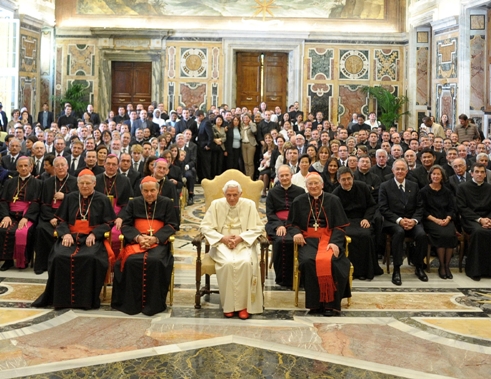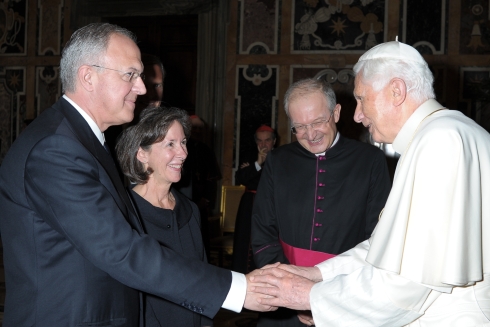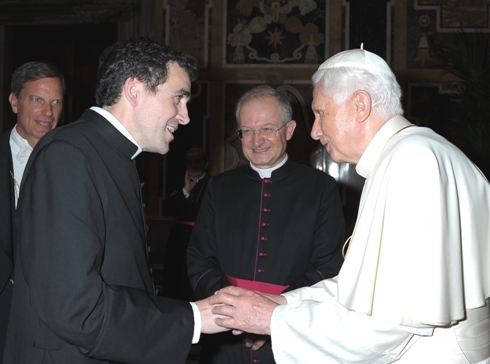Address by Benedict XVI on the Occasion of the 30th Anniversary of the Institute’s Founding

Lord Cardinals,
venerable brothers in the Episcopate and Priesthood,
dear brothers and sisters,
With joy I receive you today, only a few short days after the beatification of Pope John Paul II, who 30 years ago, as we have just heard, desired to found both the Pontifical Council for the Family and your Pontifical Institute; two organisms that demonstrate his firm conviction of the decisive importance of the family for the Church and for society. I greet the representatives of your extensive community, which has now spread to every continent; I also greet the valuable Foundation for Marriage and the Family that I created to support your mission. I thank the president, Monsignor Melina, for the words he has addressed to me on behalf of all. The newly beatified John Paul II, who, as was just recalled, was the victim of the terrible assassination attempt in St. Peter’s Square exactly 30 years ago today, entrusted particularly to you, for study, research and promulgation, his “Catecheses on Human Love,” which contain a profound reflection on the human body. To bring the theology of the body together with the theology of love in order to arrive at the unity of man’s path: this is the theme that I would like to indicate as the horizon for your work.
Shortly after Michelangelo’s death, Paolo Veronese was called before the Inquisition with the accusation of having painted inappropriate figures in a depiction of the Last Supper. The painter said that in the Sistine Chapel, too, the bodies were depicted nude, with little reverence. It was precisely the inquisitor who defended Michelangelo with a response that has become famous: “Do you not know that in these figures there is nothing that is not of spirit?” We moderns have a hard time understanding these words because the body appears to us as inert, heavy matter that is opposed to the consciousness and the freedom of the spirit. But the bodies Michelangelo painted are inhabited by light, life, splendour. He wanted to show in this way that there is a mystery hidden in our bodies. In our bodies, the spirit manifests itself and acts. They are called to be spiritual bodies, as St. Paul says (cf. 1 Corinthians 15:44). We can thus ask ourselves: can this destiny of the body illuminate the stages of its journey? If our body is called to be spiritual, shouldn’t its history be the history of an alliance between body and spirit? In fact, far from being opposed to the spirit, the body is the place where the spirit can dwell. In light of this it is possible to understand that our bodies are not inert or heavy: they speak, rather, if we know how to listen, the language of true love.
We find the first word of this language in the creation of man. The body speaks to us of an origin that we do not confer on ourselves. “You knit me together in my mother’s womb,” the Psalmist says to the Lord (Psalm 139:13). We can say that the body, in revealing to us the Origin, bears in itself a filial meaning because it reminds us of our generation, which comes from God the Creator through our parents, who transmitted life to us. Only when man recognizes the primordial love that gave him life, can he accept himself, can he reconcile himself with nature and the world.
The creation of Adam is followed by that of Eve. The flesh, received from God, is called to render possible the union of love between man and woman and to transmit life. Before the Fall the bodies of Adam and Eve appear in perfect harmony. There is a language in them that they did not create, an eros rooted in their nature, which invites them mutually to receive themselves from the Creator, in order to be able thus to give themselves.
So, we understand that in love man is “re-created.” “Incipit vita nova,” Dante said (“Vita Nuova I, 1) — “the new life begins” — the life of the new union of the two in one flesh. The true appeal of sexuality is born from the greatness of this horizon that discloses integral beauty, the universe of the other person and of the “we” that is born in the union, the promise of the communion that is hidden there, the new fruitfulness, the path that love opens toward God, the font of love. The union of one flesh is thus made a union for life so that man and woman also become one spirit. In this way a path opens up whereby the body teaches us the value of time, of the slow maturation in love. In this light the virtue of chastity takes on a new meaning. It is not a “no” to pleasures and to the joy of life, but the great “yes” to love as a profound communication between persons, which requires time and respect; as a journey together toward fullness and as love that becomes capable of generating life and of generously welcoming the new life that is born.
The body doubtless also bears a negative language: it speaks to us of the oppression of the other, of the desire to possess and exploit. Nevertheless, we know that this language does not pertain to God’s original design, but is the fruit of sin. When it is detached from its filial meaning, from the connection with the Creator, the body rebels against man; it loses its capacity to enable communion and becomes the terrain of an appropriation of the other. Is this not perhaps the drama of sexuality, which today remains locked in the closed circle of one’s own body and in emotionalism, but which in reality can only be fulfilled in the call to something greater? It is in this regard that John Paul II spoke of the body’s humility.
A character in Paul Claudel’s play The Satin Slipper says to her beloved: “That promise which my body made you I am powerless to fulfil,” and is answered thus: “The body breaks, but not the promise…” (Day 3, Scene 13). The power of this promise explains how, in salvation history, the Fall is not the last word on the body. God also offers man the path of the redemption of the body, whose language is preserved in the family. If Eve received the name Mother of the Living after the Fall, this testifies that the power of sin does not succeed in erasing the original language of the body, the blessing of life that God continues to offer when man and woman unite in one flesh. The family is the place where the theology of the body and the theology of love intersect. Here we learn the goodness of the body, its witness to an Origin that is good, in the experience of love that we receive from our parents. Here the gift of self in one flesh is lived out in the conjugal charity that joins the spouses. Here the fecundity of love is experienced and our life is interwoven with that of other generations. It is in the family that man discovers his relationality, not as a self-actualized, autonomous individual, but as a child, a spouse, a parent, whose identity is founded on being called to love, to receive himself from others and to give himself to others.
This path from creation attains its fullness in the Incarnation, in the coming of Christ. God has taken on the body, he has revealed himself in it. The upward movement of the body is integrated here into a more primordial movement, the humble movement of God who lowers himself toward the body in order then to raise it up to himself. As Son, he received the filial body in gratitude and obedience to the Father and gave his body for us, to generate thereby the new body of the Church. The liturgy of the Ascension sings this history of the flesh, sinful in Adam, assumed and redeemed in Christ. It is a body that becomes ever more full of light and of the Spirit, full of God. Here the profundity of the theology of the body emerges. Read within the tradition, it avoids the danger of superficiality and permits us to grasp the grandeur of the vocation to love, which is a call to the communion of persons in the double form of the life of virginity and of matrimony.
Dear friends, your Institute is placed under the protection of the Mother of God. Dante spoke of Mary in words that are illuminating for a theology of the body: “In your womb love was rekindled” (Paradiso 23, 7). In her female body, the Love that generates the Church took on a body. May the Mother of the Lord continue to protect your journey and to make your study and teaching fruitful, in service to the Church’s mission for the family and society. May the Apostolic Benediction, which I bestow on all of you from my heart, accompany you. Thank you.
Photo history:

Pope Benedict greets Mr. and Mrs. Carl Anderson, as Msgr. Melina looks on at the 30th anniversary celebration.

Pope Benedict greets Fr. Antonio López.
Photos courtesy of L’Osservatore Romano – Servizio Fotografico